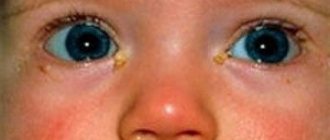Is it possible to drip breast milk into the nose of infants with a runny nose?
When a child gets sick, the question arises of how to treat him. You don’t always want to resort to drug treatment, especially for infants. Mothers are trying to try alternative treatment, one of which is breast milk. It not only serves as nutrition, but also has the ability to fight the runny nose.
Runny nose in a small child
When a child under one year old gets sick, he cannot describe his sensations and pain.
A disease such as a runny nose, without treatment, can spread pathogens to other organs . This is due to the structure of the nasopharynx and mucous membrane.
As a result, the infection quickly descends to the lower respiratory organs. Complications of a runny nose include otitis media, bronchitis, laryngitis, and pharyngitis.
Due to swelling and inflammation of the nasal passages, it becomes difficult for the child to breathe. Infants cannot blow their nose out of the accumulated mucus, and the infection begins to intensify its effect every day. Appetite disappears, the baby sucks milk intermittently, becomes capricious and irritable, and his sleep is disturbed.
The benefits of a magic drink
Is it possible to put breast milk in your nose if you have a runny nose? Undoubtedly, it contains many useful substances, including antibodies that can resist infections. They form the child’s immunity at the moment when he feeds on mother’s milk. It is necessary to take into account the fact that such immunoglobulins are effective only when they are in the blood. They get there from the child's stomach.
By dripping any milk into your nose, you can create even more favorable conditions for the proliferation of pathogenic microbes. Lactose will take care of this, which will feed microbes and viruses. Bacterial rhinitis may develop. Further digging can lead to even more serious problems.
In addition, the mucus that appears in the nose as a result of a virus or bacteria is a response from the body. It contains much more protective substances than milk.
If a woman decides to use a similar method for a runny nose in a baby, then she should adhere to the following recommendations.
- You can drip up to four times a day.
- It is enough to drop 2 drops of breast milk into each nasal passage.
- You can instill it in its pure form, but it is better to dilute it with saline in a 1:1 ratio. This will prevent the risk of milk turning into a thick curdled mass.
- Before the procedure, you should clear your nose of mucus.
- After instilling milk, after a while you need to clean the nasal passages again.
What is the advantage of this treatment
- This method promotes good hydration of the nasal mucosa. This relieves nasal congestion and improves breathing.
- You can put breast milk in your nose if crusts have appeared in it.
Thanks to this, they soften and do not cause discomfort. - Thick mucus thins out and comes out faster.
It is better to use this method for preventive purposes.
In the case where the infection has taken over, you should not count on a speedy recovery in this way.
How to quickly get rid of a runny nose
To help your child get rid of a runny nose in a short time, you need to consider some points.
- To free your nose from accumulated mucus, you need to purchase a special aspirator from the pharmacy. With its help you will quickly and easily remove mucus.
- Effective are saline solutions, which you can buy at the pharmacy or make yourself. Buy the medicine only in drops.
- It is important to monitor the temperature and humidity in the room. Dry and cold air further aggravates the course of the disease.
- If there is no temperature, the weather is warm and dry outside, then walking is recommended.
- It is imperative to give your child warm clothes. Make sure your feet are warm.
- The baby should be put to the breast as often as possible and, if necessary, given additional fluids. This will thin out the thick mucus.
- If treatment is started late or does not help, it is necessary to use medications that will cope with microbes.
- In some cases, local antibacterial drops are prescribed for a runny nose.
Any drops can only be prescribed by a doctor. It is important to dose the medicine correctly according to the child's age, weight and health status.
A runny nose is not a harmless symptom
In young children, a runny nose can lead to more serious problems in the body. You should definitely consult a doctor in the following cases:
- high temperature rose against the background of a runny nose;
- the duration of the disease exceeded two weeks;
- sleep disturbances have appeared, the child does not eat well, is constantly irritated and capricious;
- there was a cough.
When clear mucus turns yellow or green, drug treatment is necessary. The child should be shown to a doctor (ENT specialist or pediatrician).
Milky crusts in the nose are the result of improper feeding
In some cases, mothers notice milk residues in the baby’s nose without special instillation. If the rules are not taken into account during breastfeeding, regurgitation may occur through the nasal cavities. This is harmful for the child because:
- the mucous membranes of the nose are exposed to hydrochloric acid and pieces of milk that has already coagulated in the stomach;
- adenoids and polyps may develop;
- dry crusts form in the nose;
- breathing becomes difficult.
Therefore, it is important for the mother to properly attach the baby to the breast during feeding. The head should be slightly raised. Before eating, you can do a light massage in the form of circular movements. After feeding the baby, you should carry him in your arms in an upright position for some time. It is important not to overfeed the child and maintain intervals.
If any problems occur in the health of a child under one year of age, you should consult a pediatrician. You should not listen to the opinions of other mothers and relatives - this will avoid complications. Modern methods of treating diseases allow you to get rid of a runny nose quickly and without unnecessary harm.
Source: https://grudnichky.ru/lekarstvo/moloko-v-nos-grudnichkam.html
The benefits of a magic drink
Is it possible to put breast milk in your nose if you have a runny nose? Undoubtedly, it contains many useful substances, including antibodies that can resist infections. They form the child’s immunity at the moment when he feeds on mother’s milk. It is necessary to take into account the fact that such immunoglobulins are effective only when they are in the blood. They get there from the child's stomach.
By dripping any milk into your nose, you can create even more favorable conditions for the proliferation of pathogenic microbes. Lactose will take care of this, which will feed microbes and viruses. Bacterial rhinitis may develop. Further digging can lead to even more serious problems.
In addition, the mucus that appears in the nose as a result of a virus or bacteria is a response from the body. It contains much more protective substances than milk.
If a woman decides to use a similar method for a runny nose in a baby, then you need to adhere to the following recommendations.
- You can drip up to four times a day.
- It is enough to drop 2 drops of breast milk into each nasal passage.
- You can instill it in its pure form, but it is better to dilute it with saline in a 1:1 ratio. This will prevent the risk of milk turning into a thick curdled mass.
- Before the procedure, you should clear your nose of mucus.
- After instilling milk, after a while you need to clean the nasal passages again.
What is the advantage of this treatment
- This method promotes good hydration of the nasal mucosa. This relieves nasal congestion and improves breathing.
- You can put breast milk in your nose if crusts have appeared in it. Thanks to this, they soften and do not cause discomfort.
- Thick mucus thins out and comes out faster.
It is better to use this method for preventive purposes. In the case where the infection has taken over, you should not count on a speedy recovery in this way.
Breast milk for a runny nose in infants: can it be given to a child?
Breast milk is a remedy that is still used by some mothers as a cure for runny nose in newborns. Most doctors are skeptical about this method, arguing for the lack of effectiveness of putting milk in the baby’s nose.
Is it possible to drip milk into a baby's nose? Is this treatment effective? What can replace breast milk? How to bury it correctly? What does Dr. Komarovsky think about the benefits of breast milk for runny noses in infants?
Is it possible to put breast milk in the nose when a child has a runny nose?
A runny nose in an infant is a symptom of an infectious or viral disease. Children have a very difficult time dealing with nasal congestion - their sleep and appetite worsen, and their general well-being worsens. The only way to relieve this symptom is to drain the nasal passages due to the lack of nose blowing skill.
The case for breast milk treatment
Treatment with breast milk is imposed on young mothers by the older generation - grandmothers and great-grandmothers, who always used it for a runny nose in their infants. They argue that previously there were no such quantities of medicines in pharmacies, but children got sick less.
The views of modern parents have changed significantly. The only argument for treating a runny nose with milk is its ability, like any other liquid, to moisturize the nasal mucosa, due to which intensive removal of crusts occurs. Many grandmothers are also confident that it has a strong antibacterial effect, but this opinion has no scientific evidence.
What do opponents of this therapy method say?
Many young mothers and doctors claim that this method is not beneficial. In some cases, this method of treatment can lead to serious consequences. These include:
- Infection of mucous membranes. Breast milk is a habitat for various microorganisms, which, when they come into contact with the mucous membranes of the nose, begin to actively multiply and transform into pathogenic bacteria. Staphylococcus aureus, Klebsiella rhinoscleroma, or Candida fungus can be introduced into the nasal passages.
- Blockage of the nasal passages. Instilling milk can cause the formation of crusts and, as a result, blockage of the nasal passages and difficulty breathing.
- Development of complications. Pediatricians do not approve of this method and insist that it is ineffective. If a mother treats her child this way, she is wasting her time. Improper therapy leads to the development of bronchitis, sinusitis and other inflammatory diseases of the ENT organs and respiratory tract.
The effectiveness of sanitizing the nasal passages depends on the contents of the drug. Drops and sprays containing saline solution or sea salt help relieve inflammation and relieve symptoms.
Breast milk enriched with immunoglobulins is beneficial only when it enters the intestines, where it promotes the formation of healthy microflora.
Accordingly, a nursing mother should put her baby to her breast as often as possible in order to strengthen the immune system and help the baby get rid of the disease as quickly as possible.
Rules for the procedure
If the mother is still confident in the effectiveness of the procedure, she should first study all the rules for its implementation. For instillation you will need fresh expressed milk.
It is a favorable habitat for various microorganisms, which, under suitable conditions, begin to multiply and subsequently cause harm to health.
If milk has been at room temperature for half a day, it cannot be used.
Before using nose drops, it must be cleared of mucus using a baby bulb or aspirator.
Some parents resort to using cotton wool coated with baby oil to remove mucus buildup from the nasal passages. Instillations should be carried out at intervals of 3 hours, i.e. 4-6 times a day.
To carry out the procedure you will need a pipette. No more than 2 drops can be administered into each nasal passage at a time.
When using milk as the main treatment for the common cold, parents should monitor changes in the child's condition during therapy. If the desired result is not observed several days after the start of treatment, the mother should consult a doctor.
In what cases is it strictly forbidden to drip milk into a child’s nose?
Lack of effectiveness is not the only problem that a mother using this method may encounter.
Worsening of the condition, development of complications in the form of inflammatory diseases of the upper and lower respiratory tract - this is not the entire list of consequences from the use of breast milk for instillation.
First of all, they concern those children for whom this method of treating a runny nose is contraindicated - these are small patients with:
- Lactose intolerance. The consequence of milk therapy can be an allergic reaction - itching, rash, Quincke's edema.
- Severe runny nose. If a child has complications - a foul runny nose, yellow or green mucous discharge from the nose, as well as itching in the nose or ears, then its use will not be beneficial, but, on the contrary, will aggravate the child’s condition.
- Physiological runny nose. The main method of treatment and prevention is to constantly humidify the room in which the child sleeps.
Komarovsky's opinion
Dr. Komarovsky outlined his vision of the issue of the effectiveness of nasal instillation of breast milk in his own book. He is skeptical about this method of treating a runny nose, claiming that milk does not have disinfecting properties, because this has not been proven by anyone.
Young mothers take up this method due to inexperience, fatigue or hopelessness.
Having tried all the expensive drops and sprays against the runny nose, which do not have an immediate effect, nursing mothers, in search of a reliable remedy, turn to their parents, and they recommend to them their proven method, with which they used to treat all family members.
Dr. Komarovsky focuses on constant humidification of the room where a small child sleeps and plays. For instillation, he recommends using only saline solution.
Source: https://www.deti34.ru/ukhod/narodnie-sredstva/grudnoe-moloko-v-nos-grudnomu-rebenku.html
Treatment of runny nose in infants with breast milk
Milk is a source of a large number of nutrients necessary for the normal development of an infant. It contains vitamins, minerals and organic acids that help strengthen the newborn’s immune system. The main components that make up milk include:
- proteins – casein and whey proteins contribute to the intensive development of bone and muscle tissue;
- lactose is the main source of carbohydrates that takes part in the normalization of the central nervous system;
- fatty acids – have a beneficial effect on the gastrointestinal tract and help increase the body’s reactivity;
- vitamins - take part in many biochemical processes, which helps strengthen general and local immunity;
- micro- and macroelements – contribute to the normal development of the skeleton and muscles;
- antibodies – prevent the penetration of microbes and viruses into the body, leading to the development of acute respiratory infections.
Human milk is a balanced, easily digestible product that is healthier than cow's milk and infant formula.
Milk and runny nose
Is it possible to put breast milk in your nose? According to some traditional healers, mother's milk is a universal antiviral and antibacterial agent that can be used as a medicine to eliminate rhinitis. But is this really so?
The nutritional fluid contains antibodies, which form the newborn’s immunity. However, the medicinal properties of the product appear only when its main components are in the child’s blood. Experts warn that antibodies are not absorbed into the body through the mucous membranes of the ENT organs, and therefore do not contribute to the elimination of pathogenic flora in areas of inflammation.
Dropping breast milk into the nose during a runny nose can only harm the newborn.
The product contains proteins that are a favorable environment for the development of pathogenic microbes. Inappropriate use of milk can cause a bacterial infection to accompany ARVI, which can lead to the formation of ulcers in the nasopharyngeal mucosa and the development of sinusitis.
Danger of using milk
Why shouldn't you put breast milk in your newborn's nose? The antimicrobial and anti-inflammatory properties of the product appear only when taken orally. Using it as medicinal drops can be not only useless, but also dangerous, due to the following reasons:
- after instillation of the product, crusts form in the nasal passages, which prevent normal breathing through the nose;
- ineffective treatment of colds can cause the development of bronchitis, sinusitis and pneumonia;
- The product contains lactose, which is an ideal substrate for the development of aerobic bacteria.
Check with your pediatrician before putting breast milk into your nose. Many parents are confident that a natural product is no less dangerous for the child’s health than synthetic nasal drops.
In fact, drugs containing toxic substances are not used to treat rhinitis in infants.
As a rule, children's preparations for the common cold are made on the basis of saline solution or sea salt, which has anti-inflammatory properties.
Important! Do not use vasoconstrictor drops to treat a newborn without the advice of a specialist.
Possible complications
Most pediatricians and otolaryngologists are confident that it is absolutely forbidden to instill breast milk into the nose of an infant.
When consumed orally, the product helps improve immunity, which reduces the risk of developing colds.
At the same time, we should not forget that a woman can be a carrier of pathogenic bacteria and viruses, which in a child’s body will provoke the development of the disease. Some of the most common ones include:
- Staphylococcus aureus is a gram-positive bacterium, which, when it enters a child’s body, leads to damage to internal organs and the formation of ulcers on the skin. Staphylococcal infections are resistant to antimicrobial agents, which reduces the effectiveness of antibacterial therapy. Failure to eliminate the infection in a timely manner can cause the development of otitis media, pneumonia, cardiovascular diseases, etc.;
- Klebsiella is a gram-negative anaerobic bacterium, the development of which is fraught with damage to the gastrointestinal tract, genitourinary system, upper respiratory tract and brain. The active development of the bacterial environment in the child’s body causes pneumonia, sepsis, rhinoscleroma, tracheitis, enterocolitis, cystitis, etc.;
- Candida fungi are a yeast-like fungus that is classified as an opportunistic microorganism. The multiplication of the fungus in the child’s body leads to the appearance of a white coating on the mucous membranes, which indicates the development of thrush.
To prevent complications, if your newborn has a runny nose, seek help from your pediatrician. After examination and testing, the specialist will be able to determine the type of pathogens that provoked inflammation, which will facilitate the choice of the optimal course of treatment.
Features of the course of a runny nose in infants
Most diseases occur in infants completely differently than in adults. This is due to unformed immunity, as well as to the structural features of some organs. That is why a specialized doctor deals with childhood diseases.
In small children, the nasal passages are very narrow, but the mucous membrane swells very quickly and severely during various diseases.
Babies cannot breathe normally through their mouths; moreover, it is simply impossible to drink milk and try to breathe through their mouth at the same time.
It is this factor that explains why the baby refuses to eat during a runny nose or is reluctant to breastfeed. In an infant, a runny nose can cause weight loss, weakness and decreased immunity.
Babies with a clogged nose have severe sleep disturbances. They become whiny and capricious, and, as you know, tears clog your nose even more. It turns out to be a vicious circle, and the disease drags on greatly. Little children do not yet know how to blow their nose, and it is very difficult for them to clean their nose properly.
Source: https://yazdorov.win/beremennost/lechenie-nasmorka-u-grudnichkov-grudnym-molokom.html
Breast milk for a runny nose in infants: treatment and is it possible to drip
Almost all colds in children begin with a runny nose, and not all parents are in a hurry to take medications. Most often, folk remedies are used; breast milk in the nose is especially popular for a runny nose. Thanks to useful substances, such as immunoglobulin, it helps to activate local immunity.
Let's take a closer look at whether it is possible to instill milk when you have a runny nose?
What do you need to know about manifestation?
It is the baby and infant who are more difficult than others to endure infectious diseases that occur in the upper respiratory tract. A runny nose in children, in most cases, begins suddenly and progresses quickly. The whole difficulty lies in the fact that children cannot yet breathe through their mouths.
If breathing is difficult, the child may lose his appetite and his general condition may worsen. You can also observe a number of signs that indicate oxygen starvation (the skin turns pale, problems with sleep begin).
Rhinitis is characterized by the following symptoms:
- discharge appears in the nasal passages;
- the child is constantly capricious;
- the state becomes lethargic;
- sleep is disturbed;
- appetite decreases or is completely absent;
- the skin becomes pale;
- refuses breastfeeding;
- When breathing, a wheezing sound is heard.
The biggest difficulty that doctors and parents face is drainage of the nasal passages: newborn children do not yet have the skills to blow their nose.
Composition of milk
Before talking about whether breast milk should be used as a medicine for a runny nose in a baby, it is worth talking about its composition.
Milk contains large quantities of beneficial substances that help children develop normally in infancy. It is rich in vitamins, minerals and acids of organic origin. All these components together serve to strengthen the baby’s immune system.
The main components in the composition are:
- Protein. Casein and whey proteins help actively develop skeletal bones and muscles.
- Lactose. Thanks to it, the body receives carbohydrates that normalize the functioning of the central nervous system.
- A number of fatty acids. They improve the functioning of the gastrointestinal tract.
- Vitamins. Thanks to them, general and local immunity is strengthened.
- Micro- and macroelements. Responsible for the proper growth and development of skeletal bones and muscles.
- Antibodies. Due to them, the body is protected, they do not allow harmful microbes and viruses to penetrate, due to which an acute respiratory disease may begin to develop.
Many people of the older generation endow breast milk with healing properties for the common cold, which appear due to maternal antibodies that help the child’s body fight viruses and bacteria.
Yes, the immune system will be stronger, but only if the baby eats milk.
If we drip milk into our nose, the beneficial properties of the product will not provide it with any protection: the effectiveness of antibodies is activated only in the blood plasma.
Help from breast milk can only be obtained after drug treatment for a runny nose. With its help you can get rid of crusts that have dried in the nasal cavity, but even here there are a lot of other means.
If we talk about direct treatment with breast milk, then it is instilled at the rate of 2 drops in each nostril. Use is acceptable as a pure product or using saline solution for dilution 1:1. Before you start dripping breast milk into your nose, you need to thoroughly rinse your nasal cavity.
Breast milk for a runny nose is unlikely to be a good remedy. At best, it will moisturize the nose and make breathing easier during congestion. When instilled, the crusts that cover the mucous membrane soften, and the mucus itself also liquefies.
Dangerous aspects of such a remedy
The main harm that treatment of a runny nose with breast milk can cause is the strengthening of the infectious form. The lactose contained in the product becomes a beneficial environment for pathogens that provoke pathogenic rhinitis - the appearance of purulent discharge in the snot and constant congestion.
When milk gets into the nasal passages, the infection begins to spread further throughout the body - through the throat and paranasal sinuses. Complications of a very serious nature may begin, such as pharyngitis, otitis media, sinusitis. All these diseases are very dangerous and often end in the child’s hospitalization.
Before instilling breast milk into the nose, it is recommended to consult a doctor and follow his recommendations, using medications that are not harmful to the child’s body.
Cautions for Parents
If, nevertheless, parents decide to use the folk remedy discussed in the article for a runny nose in a baby, then they should know that they should not expect a quick relief from snot. Breast milk has preventative qualities, not curative ones.
When choosing how to treat a baby’s runny nose: whether to drip breast milk into the nose or not, you must act with caution and use saline solution to dilute the milk. In its pure form, when it gets into the sinuses, the product often turns into a cheesy mass, which will be very difficult and problematic to get rid of.
Before deciding to drop milk into the nose, you should consult a pediatrician so as not to harm the child. Most parents are confident that the natural product will not harm the baby, but the use of nasal drops can only worsen the condition.
To dispel this myth, it is worth saying that today, to get rid of runny nose in infants, products containing toxins are not used. Most medications for children are created using saline or sea salt as a basis, which help relieve inflammation.
Doctors are extremely negative about the fact that breast milk drips from a runny nose in infants. When eating such a product, the child’s immunity increases and, along with it, the body’s resistance to colds.
It is important not to forget: women are often carriers of pathogens. Once in a child’s body, microbes can cause very serious diseases.
Tips and tricks
Before dripping breast milk into the nose, it is necessary to provide the baby with an ideal microclimate. The apartment or house must be kept constantly cool.
In a dry and hot room, the mucus in the nasal passages dries quickly and it becomes difficult for the child to breathe.
Moreover, mucus contains substances that can fight viruses, and coolness provides the necessary viscosity for this.
If a child does not have a fever during a cold, walks in the fresh air are mandatory, only without contact with other children or adults. If this is a baby, daytime sleep should only be outside or at least on the balcony.
And in order to avoid thickening of mucus in the nose, the baby must be provided with plenty of fluids and nasal rinsing.
Yulia Kalashnik
Source: https://VipLor.ru/nos/rinit/grudnoe-moloko-ot-nasmorka-u-grudnichkov
Is it possible to drip breast milk into the nose for a runny nose in infants - Your online doctor
A runny nose is an unpleasant symptom that signals the development of inflammatory processes in the nasopharynx. The appearance of mucopurulent discharge in newborns is associated with the proliferation of viral or bacterial pathogens in the upper respiratory tract. Frequent morbidity in infants is due to reduced body resistance and lack of acquired immunity.
Many young parents are confident that mother's milk has antibacterial and anti-inflammatory properties.
Therefore, it can be used as nasal drops to eliminate mucous secretions in the nasal passages of newborns. What is the opinion of experts on this matter?
Milk and runny nose
The nutritional fluid contains antibodies, which form the newborn’s immunity. However, the medicinal properties of the product appear only when its main components are in the child’s blood. Experts warn that antibodies are not absorbed into the body through the mucous membranes of the ENT organs, and therefore do not contribute to the elimination of pathogenic flora in areas of inflammation.
Dropping breast milk into the nose during a runny nose can only harm the newborn.
The product contains proteins that are a favorable environment for the development of pathogenic microbes. Inappropriate use of milk can cause a bacterial infection to accompany ARVI, which can lead to the formation of ulcers in the nasopharyngeal mucosa and the development of sinusitis.
Danger of using milk
Why shouldn't you put breast milk in your newborn's nose? The antimicrobial and anti-inflammatory properties of the product appear only when taken orally. Using it as medicinal drops can be not only useless, but also dangerous, due to the following reasons:
- after instillation of the product, crusts form in the nasal passages, which prevent normal breathing through the nose;
- ineffective treatment of colds can cause the development of bronchitis, sinusitis and pneumonia;
- The product contains lactose, which is an ideal substrate for the development of aerobic bacteria.
Check with your pediatrician before putting breast milk into your nose. Many parents are confident that a natural product is no less dangerous for the child’s health than synthetic nasal drops.
In fact, drugs containing toxic substances are not used to treat rhinitis in infants.
As a rule, children's preparations for the common cold are made on the basis of saline solution or sea salt, which has anti-inflammatory properties.
Important! Do not use vasoconstrictor drops to treat a newborn without the advice of a specialist.
Possible complications
Most pediatricians and otolaryngologists are confident that it is absolutely forbidden to instill breast milk into the nose of an infant.
When consumed orally, the product helps improve immunity, which reduces the risk of developing colds.
At the same time, we should not forget that a woman can be a carrier of pathogenic bacteria and viruses, which in a child’s body will provoke the development of the disease. Some of the most common ones include:
- Staphylococcus aureus is a gram-positive bacterium, which, when it enters a child’s body, leads to damage to internal organs and the formation of ulcers on the skin. Staphylococcal infections are resistant to antimicrobial agents, which reduces the effectiveness of antibacterial therapy. Failure to eliminate the infection in a timely manner can cause the development of otitis media, pneumonia, cardiovascular diseases, etc.;
- Klebsiella is a gram-negative anaerobic bacterium, the development of which is fraught with damage to the gastrointestinal tract, genitourinary system, upper respiratory tract and brain. The active development of the bacterial environment in the child’s body causes pneumonia, sepsis, rhinoscleroma, tracheitis, enterocolitis, cystitis, etc.;
- Candida fungi are a yeast-like fungus that is classified as an opportunistic microorganism. The multiplication of the fungus in the child’s body leads to the appearance of a white coating on the mucous membranes, which indicates the development of thrush.
To prevent complications, if your newborn has a runny nose, seek help from your pediatrician. After examination and testing, the specialist will be able to determine the type of pathogens that provoked inflammation, which will facilitate the choice of the optimal course of treatment.
Children's nasal drops
Breast milk for a runny nose in newborns can be replaced with nasal drops, which have a pronounced anti-inflammatory effect.
As part of pediatric therapy, preparations based on sea salt, plant extracts and isotonic water are used to eliminate rhinitis.
They do not dry out the mucous epithelium, but help eliminate secretions that interfere with normal nasal breathing.
To relieve symptoms of a runny nose, experts recommend using the following types of nasal drops:
- moisturizers are safe drugs that contribute to the regression of inflammatory processes in the ciliated epithelium. They are not addictive, so they can be used up to 10 times a day for half a month;
- vasoconstrictors - symptomatic drops that help reduce swelling of the nasopharynx, resulting in easier nasal breathing. They contain components that can cause complications in case of overdose, so they are used in extreme cases to treat children from 3-4 months;
- immunomodulatory - drugs that contain components that help increase local immunity. Used to eliminate rhinovirus infections in children under 1 year of age;
- antibacterial - drugs that contain antibiotics that inhibit the development of gram-positive and gram-negative microbes. They are used exclusively for the treatment of complicated colds, due to their toxic effect.
It is undesirable to use oil solutions of the Pinosol type in the treatment of newborns, which is due to the high risk of developing an allergic reaction to the components of the drug.
Overview of nasal drops
- Children are not able to blow their nose on their own and clear the nasal passages of mucus, which, when the child is positioned horizontally, along the back wall of the pharynx can penetrate the digestive tract.
- Ineffective treatment of a runny nose leads to the development of sinusitis, sore throat, pneumonia and other complications.
- To eliminate inflammatory processes in the nasopharynx in newborns, the following types of nasal drops can be used:
- “Nazol Baby” – vasoconstrictor drops that help quickly eliminate swelling in the nasal mucosa; cannot be used in pediatric therapy for more than 3-4 days;
- "Genferon-Lite" is an immunomodulatory medicine based on interferon, which helps increase immunity and eliminate viral pathogens in areas of inflammation;
- “Otrivin Baby” is an antiphlogistic drug based on xylometazoline hydrochloride; can be used to treat children from 3 months;
- “Aqua Maris” – sterilized sea water, which helps eliminate inflammation and moisturize the nasal mucosa;
- “Aqualor” is a preparation based on sea water, which does not contain preservatives; has a pronounced antiviral, anti-edematous and wound-healing effect.
Before using the drops, the newborn's nasal passages must be cleared of accumulated mucus.
After instilling the medicine, the child should be tilted forward slightly to prevent the solution from entering the oropharynx.
Huseynova Irada
Sources: medscape.com, health.harvard.edu, medicalnewstoday.com.
Source:
Breast milk in the nose with a runny nose
Newborn babies are not immune from spontaneous hypothermia and infection in the body. Viral and bacterial pathogens lead to the development of a runny nose in infants. If an adult has an idea of methods for facilitating nasal breathing, then for infants this problem has a different scale.
Mother's milk, rich in chemical composition, is often used as a remedy for runny nose in infants. How justified this is will be discussed in this article.
Features of a runny nose in infants
Infectious diseases of the upper respiratory tract differ in severity in infants. The treatment of such diseases is carried out by individual medical specialists of a narrow profile. A child's runny nose is characterized by an abrupt onset and rapid progression. At the same time, babies do not have the skills to breathe through their mouth, which aggravates their general condition.
When a child does not breathe through his nose, he loses his appetite, his health worsens, and signs of oxygen starvation appear (pallor of the skin, sleep disturbances, weakness).
You can suspect a runny nose in a child based on the characteristic symptoms:
- the presence of mucous or watery discharge from the nasal passages;
- frequent moodiness and lethargy;
- sleep disturbance;
- decreased or lack of appetite;
- pale skin;
- refusal to breastfeed;
- characteristic wheezing sounds.
The most difficult task for doctors and parents is draining the baby's nasal passages, since newborn children do not have the skills to blow their nose.
Breast milk is a cure for a runny nose
With a limited pharmaceutical arsenal, young mothers began to use their own milk as a cure for runny nose in newborns. The justification of this method remains in doubt, since milk is a nutritional component for the child’s body that has nothing to do with medications.
The only benefit of this product is that breast milk can moisturize the mucous membrane of the nasal cavity and soften the crusts. Medical experts recommend using alternative liquids for this purpose.
Drinking mother's milk as food is beneficial for the baby's body. This will strengthen his body from the inside. By putting this product in the baby's nose, a woman risks causing additional problems, since breast milk is a breeding ground for the proliferation of pathogenic microorganisms.
For safety reasons, new parents are advised to refrain from using breast milk as nasal drops.
Is it possible to use breast milk for a runny nose in newborns?
A runny nose in children, unfortunately, is quite common. It even appears due to excessively dry air in the room where the baby lives. This is due to inability to adapt to the environment; it is a temporary phenomenon. Treatment of rhinitis must begin immediately.
The child does not know how to breathe through the mouth and breathing through the nose is the only source of oxygen. Children begin to refuse the breast or pacifier, become capricious and have trouble sleeping. This leads to decreased immunity.
Many mothers practice treatment with traditional methods. One of these means is breast milk. Can it be used to treat children's runny nose?
Baby's runny nose
Many illnesses occur differently in infants than in adults. There is a separate specialization for treating children. Rhinitis was no exception.
The nasal passages of infants have a narrow structure, and the mucous membrane can swell several times faster. Babies cannot breathe through their mouths. In addition, they cannot drink milk and breathe through their mouth at the same time.
When a baby suffers from a stuffy nose, problems associated with lack of appetite appear. Breast refusal occurs. Insufficient nutrition causes weakness and weight loss, and the disease enters a protracted stage.
Sleep patterns are also disrupted. It is difficult for the child to get enough sleep, he is capricious and cries a lot. From the abundance of tears, rhinitis becomes stronger. Babies do not know how to blow their nose, and it is difficult to clear the nasal passages.
Sometimes pharyngitis is attached to rhinitis. If the problem is not treated immediately, a number of complications arise.
Is breast milk healthy?
In the time of our ancestors, medicine could not boast of its development, unlike what is happening in our time. Diseases were treated only with traditional methods, recipes were passed down from generation to generation.
Mother's milk has always been used to treat children. They dropped it into the baby’s nose with a runny nose and waited for the illness to go away on its own. Adult residents also used such drops. The logic was obvious - if mother's milk is useful, then it is acceptable to use it for treatment.
This technique is often used to this day, but not every mother trusts it.
Medicine was able to refute the legend about the benefits of milk for treating a runny nose. Doctors say that breast milk has no effect on the treatment of rhinitis. In addition, it can harm the child:
- When milk gets into the baby's nasal passage, it blocks them. The situation is getting more complicated.
- Bacteria multiply remarkably in milk. This is dangerous and fraught with complications.
- The mucus in the baby's nasal cavity has stronger protective properties than mother's milk during lactation. Therefore, burying loses its meaning.
Composition of breast milk
Before you start talking about the possibility of using breast milk to treat infants, you need to understand what it consists of.
Milk contains many beneficial elements in large quantities. They contribute to the proper development of infants. It contains many vitamins, minerals and organic acids. All these components together help children's immunity.
Main components of milk:
- Protein. Casein protein and whey promote proper development of the skeleton and muscle tissue.
- Lactose. Helps the body receive carbohydrates, which improve the functioning of the nervous system.
- Fatty acid. Helps the functioning of the gastrointestinal tract.
- Vitamins. They strengthen the immune system.
- Elements. Responsible for the growth of skeletal bones.
- Antibodies. Help the body protect itself from germs and viruses that provoke acute diseases of the respiratory system.
Benefits for rhinitis
Breast milk against a runny nose in infants is effective due to its bactericidal properties and can increase the protective functions of the child’s body (immunity). It can make the mucous membrane more moist.
The mucus becomes less viscous. These qualities help the milk fight a runny nose. The baby's health improves and he gets rid of the problem.
Breast milk contains many enzymes and immunoglobulins. It can nourish the baby and protect against pathogenic bacteria.
For a child, milk is not only food, but also drink and a talisman against diseases. Babies who drink mother's milk get sick infrequently and develop faster, unlike children who are formula-fed.
Therapy
Traditional medicine methods initially involved the use of mother's milk. In the old days, medicine was not developed. Residents of the outback did not have access to a doctor.
The most popular method of using breast milk is:
- Milk is dripped into a child's nose. It is diluted with water in equal proportions in advance. About ten drops are applied to each nostril.
- If the baby swallows milk through his mouth, then nothing bad will happen.
- The procedure is repeated twice a day.
- Boiled water is suitable for dilution.
- You can use saline solution, which can be purchased at a pharmacy. The concentration is similar - one to one.
Before dripping breast milk into the nose of a newborn with a runny nose, you need to clear the nasal passages of mucus accumulations. Mucus is sucked out with a syringe or nasal aspirator.
Some use cotton swabs or turundas soaked in vegetable or olive oil. Disinfection is carried out in a water bath. Pharmaceutical oil for children is also suitable for this.
When using milk to treat a runny nose, it is important to monitor the baby's reaction and be prepared to supplement the therapy with other methods. Be sure to consult your doctor.
Dangerous sides
The main harm that breast milk can cause during a runny nose is an increase in the infectious environment. The product contains lactose, which is a favorable environment for the proliferation of pathogenic microflora. This leads to pathogenic runny noses, the presence of pus in the discharge and endless congestion.
When milk enters the nasal passages, the infection begins to spread throughout the child’s body – to the appendages and throat. Serious problems begin: pharyngitis, otitis media and sinusitis. All these diseases are very dangerous in infancy and are treated in a hospital.
Before dripping milk into your child's nose, consult your pediatrician.
How to treat a runny nose?
Since milk is a rather useless and dangerous remedy, the problem must be eliminated by other methods. The disease cannot be left to chance. A child's nose must be thoroughly cleaned, since the baby cannot do this on his own.
How to quickly get rid of rhinitis:
- Take care of the environment. Monitor the temperature and humidity in the room where the baby lives.
- Regularly clean your child's nose from crusts and mucus accumulations.
- Disinfect the nasal cavity.
- Watch your breathing through your nose.
Milk crusts
Sometimes mothers note the presence of milk residues in the baby’s nose, which dries and forms crusts. When breastfeeding, you can make mistakes that lead to such consequences. Some babies burp through their nose.
Disadvantages of crusts:
- The mucous membrane of the nasal cavity suffers from interaction with hydrochloric acids and milk particles that have coagulated in the stomach.
- Polyps and adenoids develop.
- Dry crusts appear.
The mother needs to properly attach the baby to her breast. The newborn's head rises. Before eating, do a small circular massage.
After feeding, the child is carried in his arms in a vertical position. It is very important not to overfeed the baby and monitor the breaks between feedings. If any problems with children's health occur, contact your pediatrician.
Precautions for parents
If parents decide to use breast milk to treat a child’s runny nose, then they should understand that there will be no quick relief from rhinitis. Breast milk has preventive rather than therapeutic effects.
When choosing a method of treating rhinitis in an infant: whether to instill milk into the nose or not, it is important to be very careful and dilute the milk with saline. If you drip milk in its pure form, it will get into your sinuses, turn into curd, and it will be very difficult to get rid of it.
Before deciding to drop milk into your child’s nose, you should consult your doctor so as not to harm your baby.
Many parents are confident that the natural component cannot lead to adverse consequences. They believe that nasal drops can worsen the baby's health.
It is worth dispelling this misconception. Currently, toxic medications are not used to treat runny nose in infants. All drugs for children are based on sea salt or saline; they relieve inflammatory processes.
Doctors have an unfavorable attitude towards the use of mother's breast milk to treat rhinitis in infants. When eating milk, children's immunity increases, and the body resists respiratory and colds.
It is worth understanding that a woman can be a carrier of pathogenic microflora. Microbes that pass to the baby through mother's milk can trigger the development of a number of diseases. Dr. Komarovsky has a negative attitude towards this type of therapy.
Breast milk is used to treat children's runny nose. However, the effect of this remedy is very doubtful. At the first symptoms of excessive nasal discharge or congestion in your baby, contact your pediatrician. The doctor will prescribe the correct, effective and safe treatment.
Source: https://ProNasmork.com/deti/grudnoe-moloko.html
Treatment of runny nose in newborns with breast milk
A runny nose in newborns, unfortunately, is a common occurrence and can even appear due to excessive dry air. This is explained by temporary unadaptability to the environment.
A runny nose must be treated immediately - the baby does not yet know how to breathe through the mouth and nasal breathing is the only vital means of supplying his body with oxygen. The baby begins to latch poorly, and his immunity weakens due to lack of nutrition. Treatment methods for rhinitis in infants differ from those for older children.
They are characterized by the loyalty and harmlessness of medicinal products. These include breast milk for a runny nose. This method belongs to traditional medicine and is auxiliary.
Benefits for a runny nose
Breast milk against a runny nose in infants is effective due to its bactericidal properties and ability to increase the child’s immunity. It also moisturizes the nasal mucosa and softens accumulated mucus. It is because of these qualities that milk helps with a runny nose, improving the child’s condition and leading to his recovery.
Breast milk consists of nutrients, bactericidal enzymes, immunoglobulins and serves to nourish and protect the baby from pathogens. It essentially provides the child with food, moisture, and protection from disease. Babies who eat it get sick less often and develop faster than children fed with artificial milk formula. >
Treatment
From time immemorial, traditional medicine has treated runny noses with breast milk. In the old days, medicine was poorly developed, and residents of distant villages were completely deprived of it. Through the transmission of healing recipes from generation to generation, wise and effective folk advice has survived to this day.
This method of treatment is as follows:
Breast milk is dripped into the baby’s nose, diluted 1:1 with sterile water, 10-15 drops in each nostril. There will be nothing terrible if it gets into the child’s mouth and he swallows it. This procedure is done 2-3 times a day. Boiled water is also suitable. Instead of water, they sometimes use saline solution purchased at a pharmacy. They also need to dilute milk 1:1.
Before instillation, the nose must be cleared of accumulated mucus by sucking it out using a small rubber syringe.
You can also resort to using cotton swabs or twisted cotton wool, applying disinfected vegetable oil to them. You can disinfect it by boiling it for 30 minutes in a water bath.
Ready-made baby oil sold in pharmacies is also suitable for this purpose.
When using milk in the nose for a runny nose or cold, you should carefully monitor the baby’s condition and be prepared to add additional treatment if necessary. Throughout treatment, close contact with the doctor is necessary. This will help avoid complications with a runny nose.
Position of traditional medicine
Traditional medicine does not recognize breast milk as capable of treating rhinitis. In particular, Dr. Komarovsky believes that it is not only useless in treating the disease, but also causes harm. Its harm lies in the content of lactic acid, which, when it enters the nasal cavity, becomes a favorable environment for the proliferation of pathogenic microbes.
As an alternative to breast milk, doctors offer:
- drip a weak infusion of chamomile into the nose;
- weak saline solution. You can buy it ready-made at a pharmacy or prepare it at home by dissolving ¼ teaspoon of sea or regular salt in 1 glass of warm boiled water;
- use oil drops in the nose;
- monitor the microclimate in the children's room: if the air is dry, take measures to humidify it; an automatic air humidifier is ideal for this purpose. If it is not possible to purchase such a device, then you can use a hand sprayer. It is necessary to maintain cleanliness - do wet cleaning and remove dust. Saturate the air with oxygen through ventilation. It is necessary to ventilate the room in the absence of the child, but do not allow the temperature to drop excessively. The air should be sufficiently humid, clean and warm.
- Regularly walk with your child in the fresh air. For a walk, you should choose a place protected from the wind.
Before use, any medication must be tested for tolerability by the child’s body. To do this, you need to drop it on the skin of the inner bend of the baby's elbow. If there is no redness, the drug can be used for treatment.
Every mother has the right to choose the method of treatment for her child. But for every mother, contact with the pediatrician treating her child is mandatory.
Source: https://domlor.ru/beremennye/grudnoe-moloko-ot-nasmorka-u-grudnichkov.html
Is it possible to treat a baby's runny nose with breast milk?
Grandmothers recommend using breast milk for runny noses in infants. These are the methods used to treat children of past generations. Women are confident that mother's milk is healing and can cure even dangerous diseases.
Natural baby food actually contains a lot of useful substances. However, modern pediatricians do not recommend putting it in the baby’s nose or eyes. Doctors consider this treatment method useless and even dangerous.
How did the recommendation to be treated with breast milk come about?
Women of past generations are usually advised to drip breast milk into the nose. For many decades, this method has successfully helped children with colds and rhinitis. Natural baby food contains immunoglobulins. They stimulate the baby's immunity and increase the body's resistance.
It is assumed that when treating a runny nose with breast milk:
- local immunity increases;
- the mucous membrane in the nasal passages is moistened;
- crusts soften;
- Infectious agents - viruses and bacteria - are destroyed.
Like most modern pediatricians, Dr. Komarovsky does not recommend putting breast milk into the nose.
This treatment was used because medicine was not sufficiently developed. Mothers did not have access to effective medicines, and sometimes had to be content with folk remedies.
With the development of medicine, alternative treatment methods have faded into the background. They are still recommended by grandmothers, especially for young children. However, such methods are not recognized by traditional medicine. Dripping breast milk into your eyes and nose is pointless. If you have any complaints, it is better to contact your pediatrician and get an individual treatment regimen with safe drugs.
Should I put it in my eyes or nose?
Grandmothers recommend that young mothers drip breast milk into the baby's nose with a runny nose at each feeding. The more often the procedure is performed, the faster the child will recover. In reality, everything is not like that. Modern pediatricians, ophthalmologists and otolaryngologists tell us why conjunctivitis and rhinitis in a newborn cannot be cured with breast milk.
- Breast milk is a nutritious liquid that contains various beneficial components. It is considered an ideal food for a child and helps to form strong immunity due to its antibody content. However, a woman's milk is not capable of destroying bacteria and viruses. It works inside the body and has no local antiseptic effect. Therefore, pouring breast milk into a baby’s nose is simply pointless.
- The mucous membrane of the nasal cavity cleanses itself due to the ciliated epithelium and secretory activity. The mucus produced flushes out harmful microorganisms and protects the inner lining of the nose. If you drop milk into a child's nose, the eyelashes will stick together. They will no longer be able to remove mucus and cleanse the nasal cavity. This can lead to complications. Therefore, using such a treatment method is dangerous.
- Human milk contains sugars. They create a favorable environment for the growth of bacteria. If you regularly carry out this procedure, an infection will appear in your nose. For the same reason, you should not put milk in the eyes of a newborn. Unconventional treatment methods will lead to dangerous bacterial diseases.
We can conclude that treating a runny nose using an unconventional method is ineffective and dangerous. Therefore, you should not self-medicate. It is better to take your child to the doctor and find out if the use of medications is required.
Many mothers say that breast milk helped their baby with a runny nose. Modern pediatricians explain this simply.
In the first years of life, the child’s body encounters various infections, most of which are viral in origin.
The baby's immunity, especially with proper organization of breastfeeding, copes well with diseases on its own. Recovery occurs within one week.
Therefore, the child who had breast milk dripped into his nose recovered not because of the unconventional method of treatment. He simply recovered on his own, despite regularly putting milk in his nose.










